Periwinkle: characteristics, planting and care in the open field
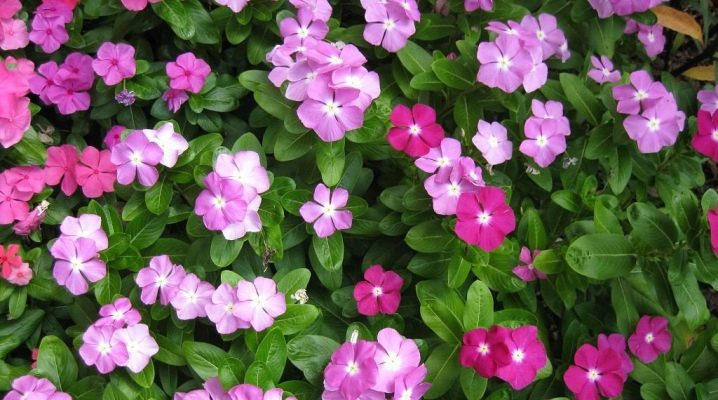
Nature has given us a gorgeous variety of plants and flowers. Some of them are designed to cure terrible diseases and soothe physical pain, others are created in order to delight us with their beauty every day, soothing the soul and heart. Today we will talk about such a mysterious plant as periwinkle, understand its features and useful properties, and also formulate the basic rules for caring for it.

general description
Periwinkle (Latin Vinca) is a genus of perennial evergreen shrub-type plants of the Kutrovy family. The homeland of this plant is Asia and Europe, as well as some areas of North Africa. From the Latin language "vinca" is translated as "twine" or "creep", which is typical for this perennial plant.
Periwinkle blooms at the beginning of spring, when the earth begins to warm up and there is enough moisture in it. At the very first stages of flowering, the periwinkle buds stretch upward; after its completion, the plant does not lose its appearance, since individual peduncles continue to bloom throughout the growing season. At the moment there is more than 12 different types of periwinkle, differing in the place of distribution and appearance.
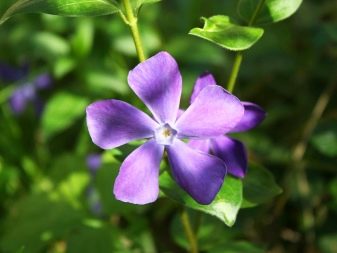
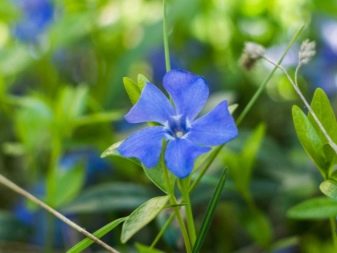
In many countries, periwinkle, due to its exceptional vitality and adaptability to any weather conditions, has become a symbol of longevity and eternal youth. The ancient Romans had a legend that once the periwinkle complained to the goddess Flora about its worthlessness and uselessness in comparison with the beauty and love of people for the violet.
The flowers of these plants bloomed almost simultaneously in the spring, but all people admired the beauty of the violet, and they did not care about the boring periwinkle. The goddess heard the call of the plant and gave him not only natural beauty, but also a longer life and flowering.
Since then, the periwinkle gained fame and began to be actively used by ordinary people in everyday life. So, for example, miraculous properties were often attributed to this perennial: the periwinkle buds collected at a certain time drove evil spirits out of the house and guarded them from lightning strikes.
Periwinkle was planted on the graves of dead people, thereby symbolizing the immortality of the human soul.
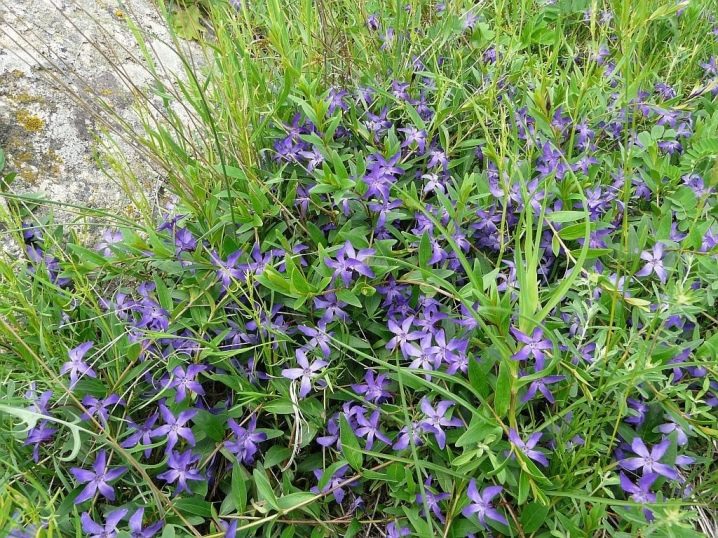
Periwinkle today is one of the most popular ornamental plants; it can be found literally everywhere: in flower beds, in parks, in gardens and artificial groves. Let's see why the periwinkle is still relevant today.
- Durability. Among Russian plants, periwinkle is considered to be something like an "eternal flower" - a flower that does not know the seasons. In the open field, this perennial is able to bloom for a very long time, despite all the unfavorable environmental conditions.
- Unpretentiousness. Many people know periwinkle as a plant that can live in the ground as long as there is at least a drop of water there. This plant does not need constant care and watering.
- Ease of seating. This is one of the easiest plants to plant in technical terms, we will talk about this in more detail later.
- Attractive appearance. This flower is ideal for people with a refined taste. Periwinkle flowers are distinguished by delicate tones that soothe and do not "hurt" the eyes.
- Utility. This perennial is full of useful properties, which we will also consider in detail a little later.
Unlike many other plants, periwinkle looks great not only in the garden, but also in landscape design.This is the kind of plant that does not lose its appearance after flowering, periwinkle bushes always look harmonious and beautiful.
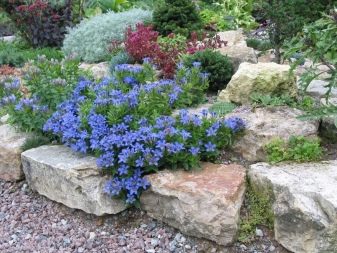

If we talk about the compatibility of the plant with other flowers, then together with periwinkle, forget-me-nots, woodlands, pansies, primroses look great. In caring hands, these flowers are able to form a living green carpet with bright splashes of scarlet, purple and golden hues.
In addition to the obvious external advantages, periwinkle has many useful and medicinal properties. Until the end of the twentieth century, this plant was actively cultivated for medicinal purposes. Vital alkaloids were found in it, which have a vasodilating effect, improve cerebral circulation, and also inhibit cell division. Most often, these alkaloids are found in the composition of immunosuppressants and antineoplastic agents.

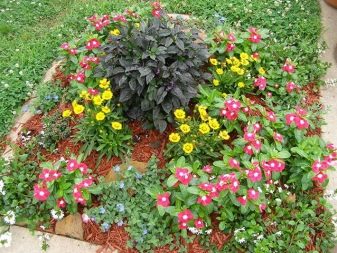
To date, the industrial production of funds from this plant has been discontinued, since a way has appeared to obtain all the necessary alkaloids by artificial means. However, the plant itself is still actively used in the treatment of cardiovascular diseases.
For example, the pubescent periwinkle contains useful glycosides such as pubescin and vinine, which are used in the creation of drugs to lower blood pressure. Herb periwinkle is rich in routine, a vital glycoside. Periwinkle pink contains the beneficial alkaloid reserpine, which is also used to lower blood pressure.
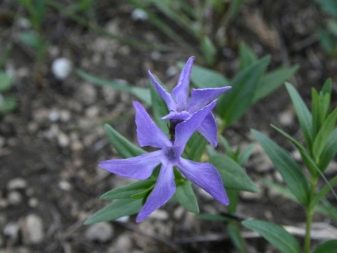
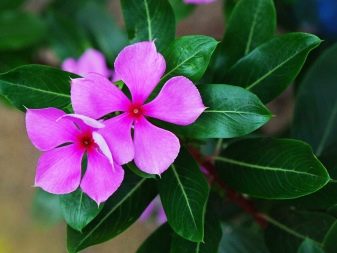
Some varieties of periwinkle contain many other beneficial elements, including ursolic acid, sugar, vitamins, and some organic acids... This perennial is still used in the treatment of diseases such as osteochondrosis, ischemia, polyneuritis, and vasomotor rhinitis. There are known cases of the favorable influence of periwinkle on the course of diseases associated with mental disorders: schizophrenia, psychosis, depression.
Periwinkle has not spared traditional medicine either. A few centuries ago, it was actively used by people to treat scurvy, diarrhea, and was used in the prevention of consumption. It was considered a universal remedy for stopping bleeding and pain in the teeth and mouth.
There is an assumption that this unique and, as many believe, a magical plant, began to be used in pharmacology in the days of Cicero.
However, periwinkle, like most plants containing alkaloids, if used incorrectly and when the dosage is exceeded, it is extremely poisonous. Most experts advise avoiding self-creation of any poultices and infusions of periwinkle, since there is a high probability of incorrectly determining the doses, confusing the plant variety / variety, which can lead to an unfavorable outcome.
Highly recommended see a good doctor to create a comprehensive treatment plan for this plant, rather than self-medicate. This is especially true for pregnant women, for whom the use of drugs based on periwinkle is contraindicated at any time.
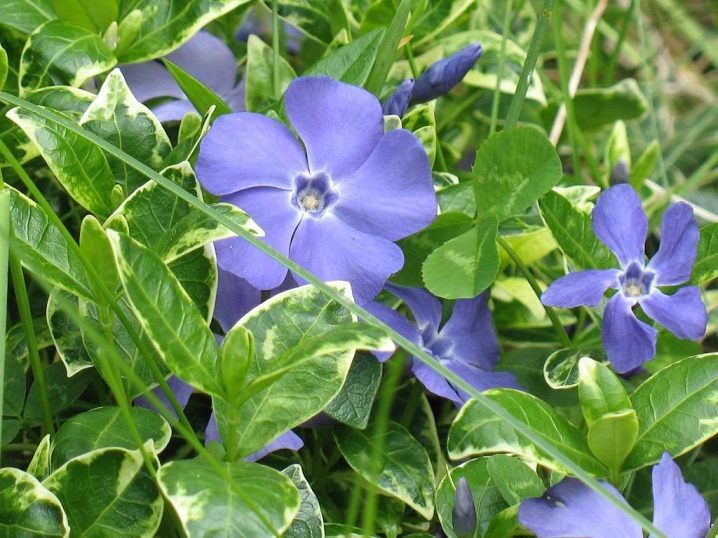
Varieties
During its rich and centuries-old history, the periwinkle managed to evolve into several full-fledged varieties and dozens of individual varieties. They differ, first of all, in appearance, seeds, environmental requirements and planting.
It should be said right away that the most common and known are 2 varieties of periwinkle: large and small. All the rest can be easily ranked among the varieties of these species, but they also have differences.

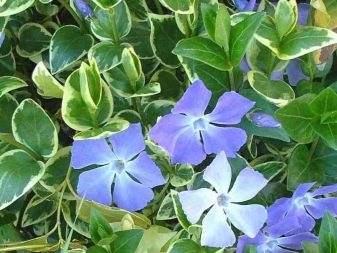
Lesser periwinkle (or "Vinca minor")
It is a fairly tall evergreen plant with rich green oval leaves. Its leaves are located opposite each other and have a characteristic healthy shine. Peduncles first grow upward up to 15-20 cm long, then fall under the weight of the buds.
Flowers, represented on the plant in huge numbers, are located in the axils of the leaves and reach a diameter of no more than 3 centimeters. Its flowering time is short - from about mid-May to mid-June (with variations depending on the time of planting or variety).
Flower shades in this case range from pure white to pale pink and purple hues. The color of the leaves can range from dark green to green with silvery, yellow, and even reddish edging. Wild periwinkle is distinguished by dark green leaves with blue flowers and a five-pointed corolla.
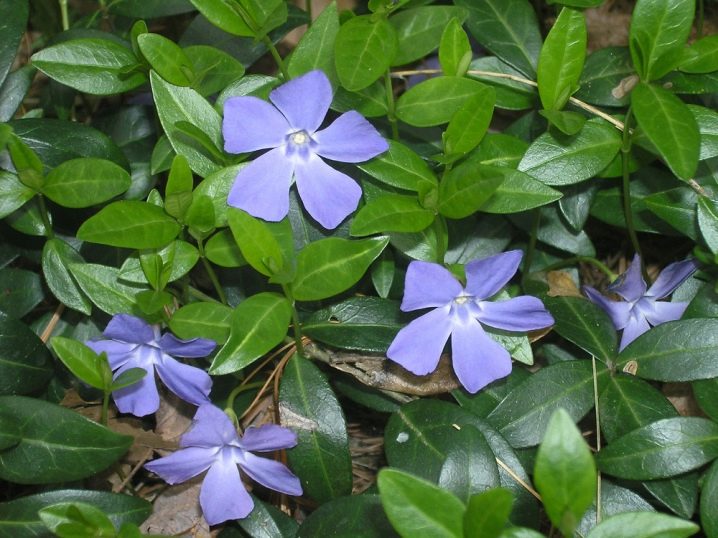
The following varieties are distinguished in this species.
- Bowles Variety - a tall variety with a large number of strong white buds, the color of the leaves is often pale green. The general appearance of the flower resembles an ordinary bell. Flowering takes place 1-2 times a year.
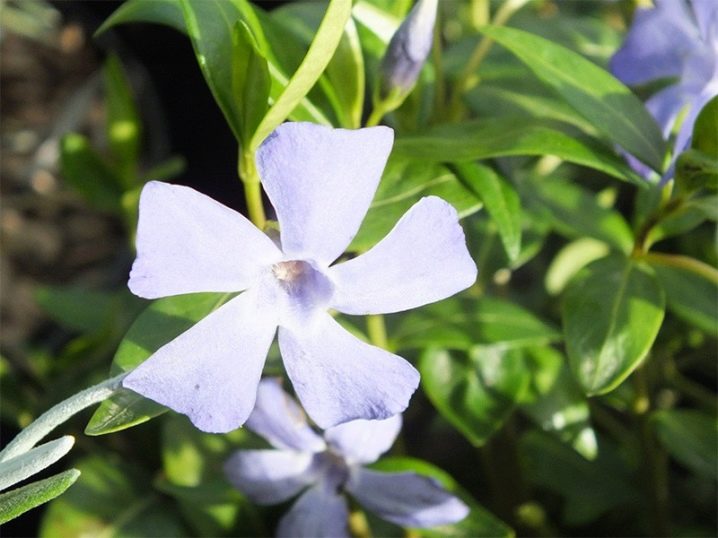
- "Dart" s Blue " - a similar variety, also distinguished by the white color of the buds, however, in this case, their color is paler, grayish, and the petals in the inflorescence are separated from each other by sharp corners.
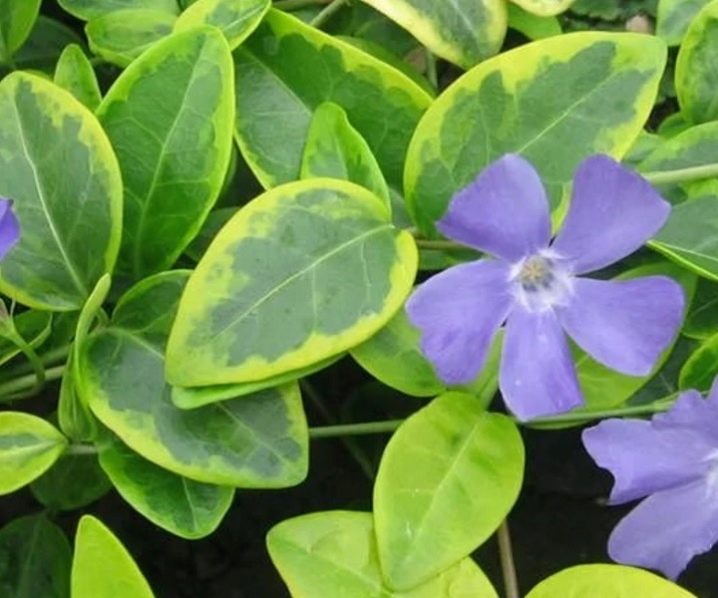
- "Marie" - a low-growing version of the periwinkle, also with a large number of white flowers.
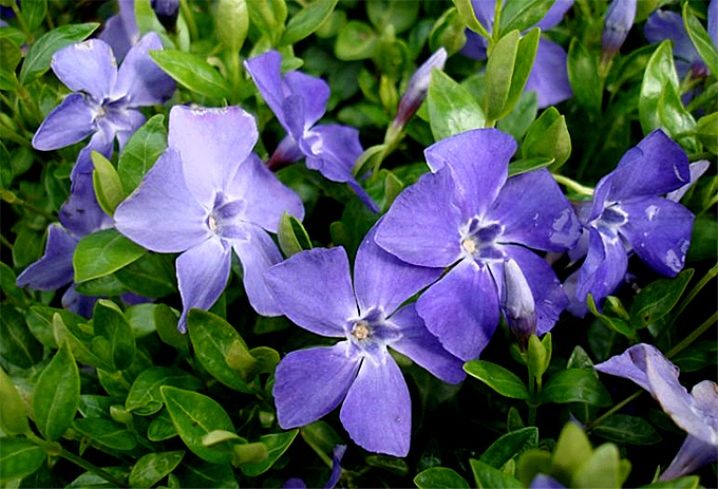
- "Emily Joy" - a young variety of periwinkle, differs from the classic variety in juicy dark leaves and a bright pink, even purple shade of inflorescences.

- "Atropurpurea" - Another popular variety, it is distinguished by a purple inflorescence, resembling a propeller in shape.
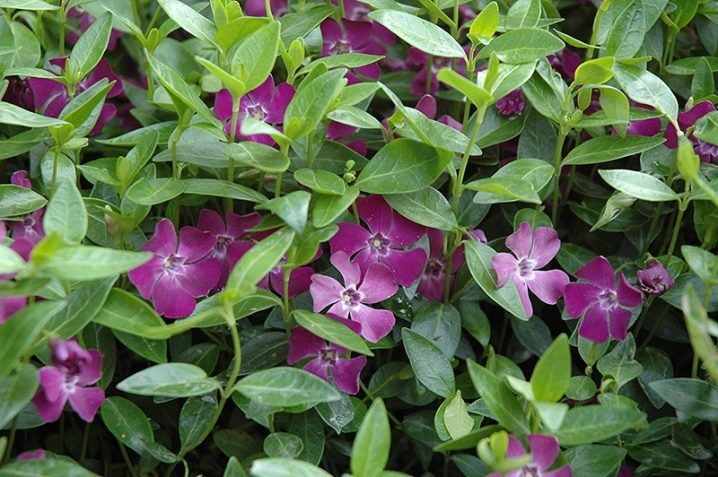
- "Double Purple" - a stable, tall and strong version of the periwinkle with rich purple hues.
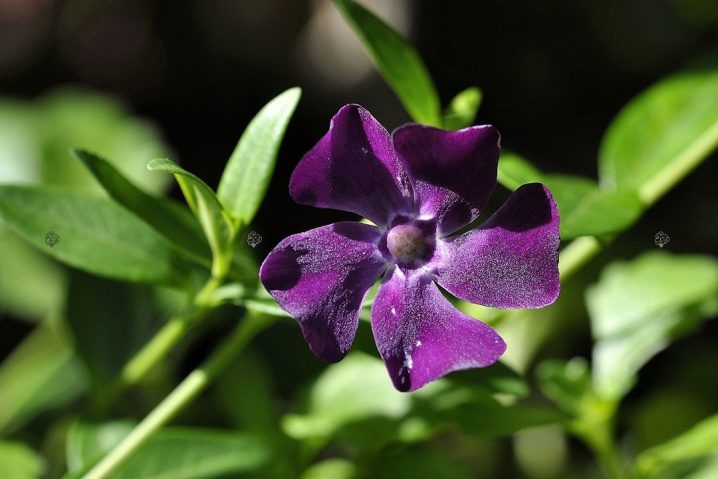
- "Variegata" - as the name implies, this is a variegated type (a hybrid version, where the colors of leaves or flowers may vary), differs in leaves of a light green color with a characteristic border of leaves (white, silvery, yellowish shades along the entire leaf). The shade of the buds can range from pale purple to vibrant reds.
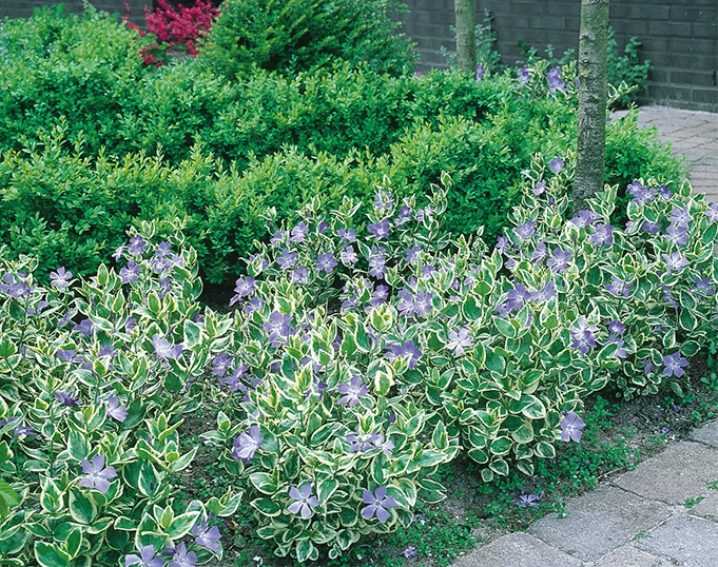
- "Golden" - periwinkle variety with almost completely yellow leaves or with a characteristic border along the entire length of the leaves.
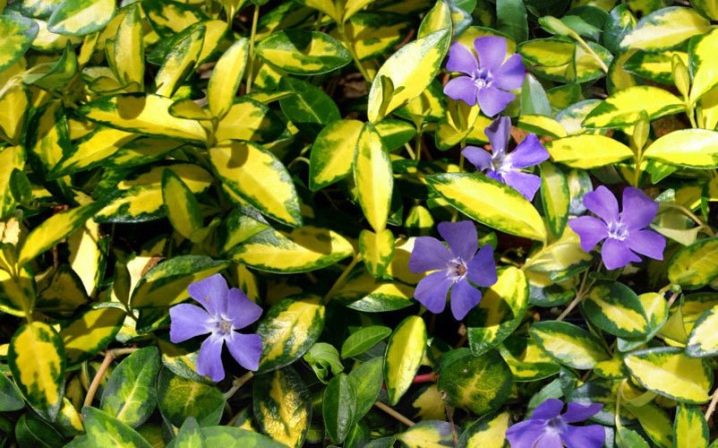
- "Moonlit" - lush buds with lots of purple petals. Leaves are light green with a thin white border. It is considered rare and one of the most beautiful varieties of periwinkle.
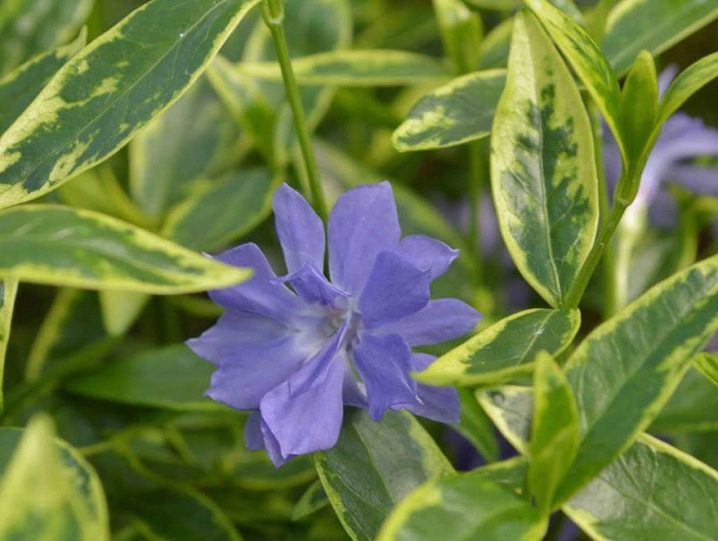
- Illumination. A characteristic feature of this garden variety is its large, dense and leathery leaves with bright yellow "strokes" on their surface. Differs in a small number of flowers and slow growth.
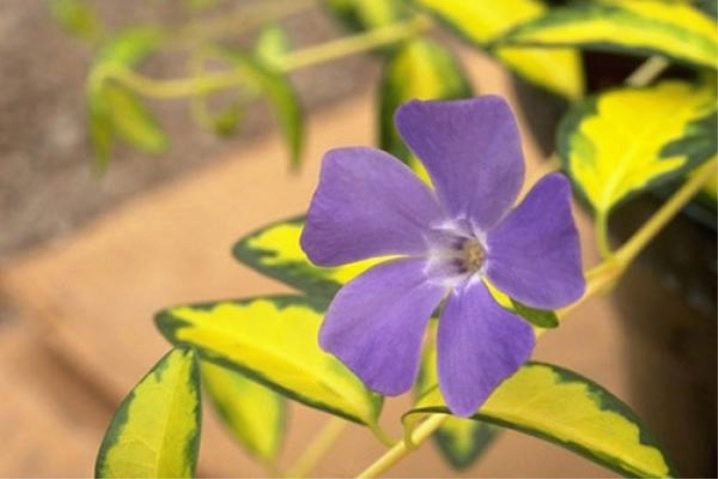
- Catharanthus roseus ("Sicily") - indoor variegated plant with light green leaves without a border and shades of buds from purple to bright red.
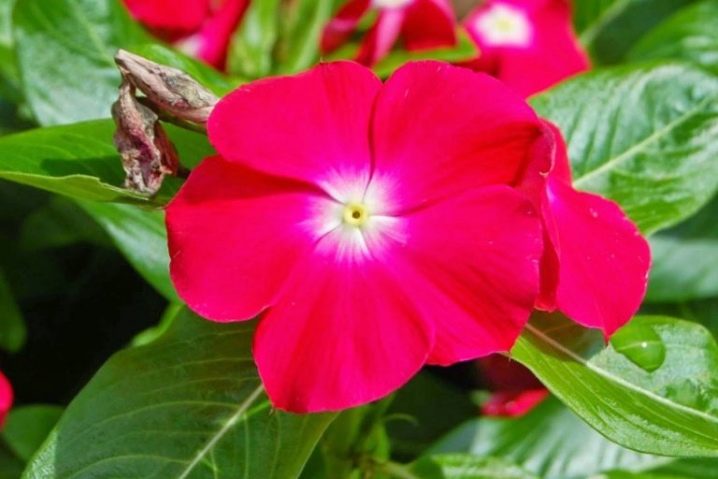
- "Pinot noir" - the ampelous version of the periwinkle with small but frequent buds of purple and pink color, differs in small green leaves and relatively small growth.
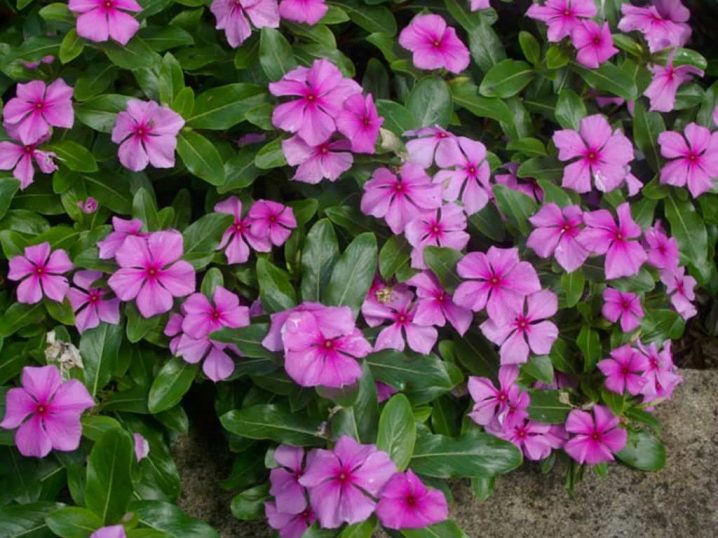
Great periwinkle (Vinca major)
It is a low-growing plant with creeping bushes. It is represented by large fleshy leaves and blue flower buds, reaching up to 5 centimeters in diameter. In this case, the number of flowers in the bush is much less. This type of periwinkle is considered much less popular among gardeners.
A distinctive feature of the small and large periwinkle can be considered the structure of the leaves - the large periwinkle has petiole leaves, the small one does not.
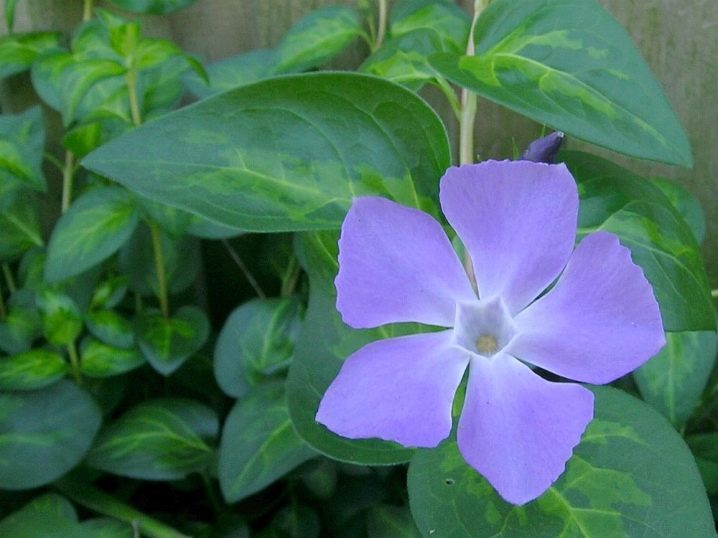
There are two common varieties of periwinkle large.
- "Variegata" - light green large leaves, bush up to 30 cm tall, rare, but large purple buds.
- "Waste paper" - fleshy large green leaves with a characteristic yellow "stroke". The color of the buds ranges from pale pink to purple.
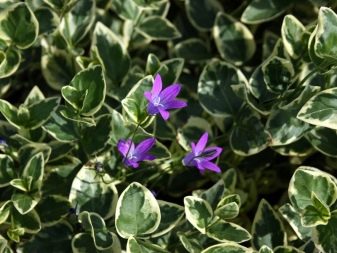
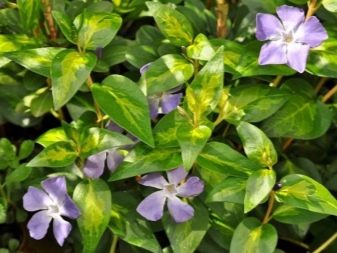
Herb periwinkle (Vinca herbacea)
Another type of periwinkle. It is most widespread in its natural environment - the flowers of this plant can often be found in warm deciduous forests and meadows. The characteristic features of the species are creeping strong and thin stems, small, rarely placed green or dark green leaves.Shades of multiple buds range from pale gray to crisp white.

Pubescent periwinkle (Vinca pubescens)
A species of periwinkle that grows only in moist warm soil (for example, in the Caucasus). Differs in small flowers (up to 3 centimeters in diameter) dark blue and pale purple in color. Blooms from mid-May to late June.
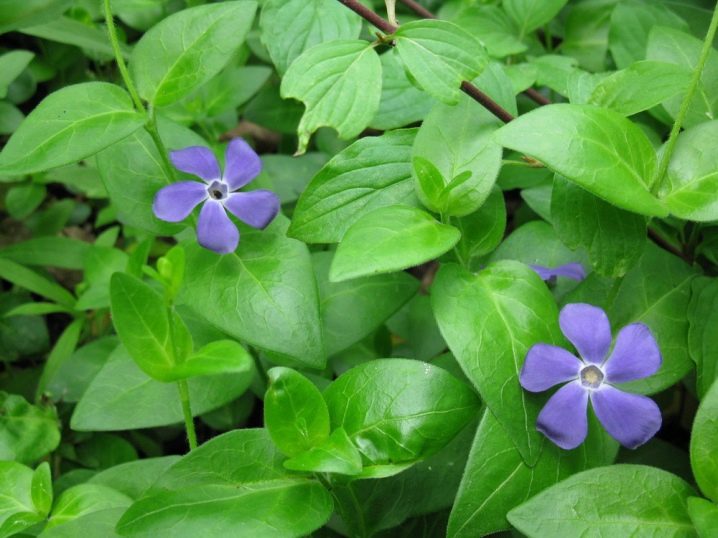
Pink periwinkle (Vinca rosea)
The plant is of medium height (40 to 60 cm). It features strong, straight stems with dark green leaves and pale pink buds. Unlike other species, periwinkle blooms from early spring to late autumn. Slow growing species.
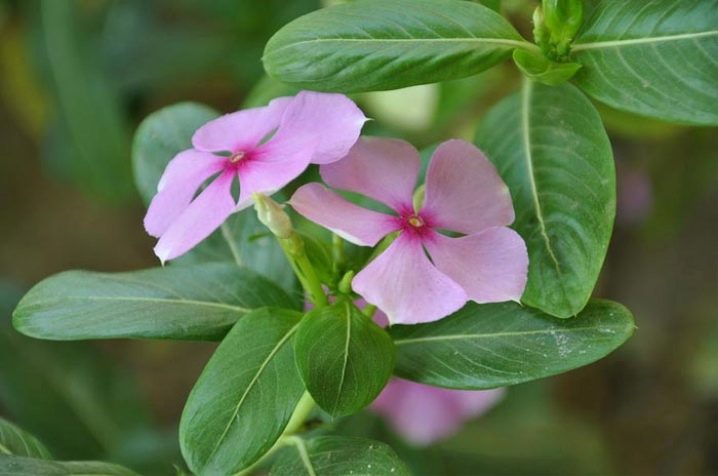
Pink periwinkle has two common varieties:
- "Grape Cooler" - purple or purple flowers with a rich pink center;
- Peppermint Cooler - light strong buds with a bright red center like a blot.
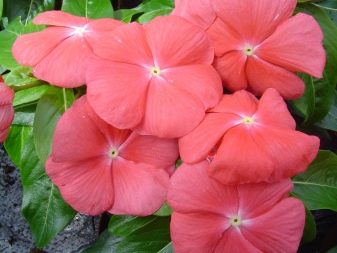
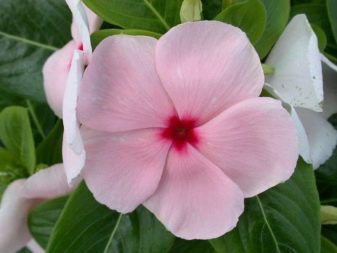
Planting and breeding
Just like all perennial plants, periwinkle can be propagated in several ways, each of which depends on the season, as well as planting conditions: soil, weather conditions, the presence of a certain place for planting.
So, there are 4 ways to breed this culture:
- seeds;
- dividing the bush part;
- by diversion;
- by cuttings.
Today, experienced owners often use the division of the bush.

In this case, a certain part of the plant is separated from the rest of the bush (along with part of the root system). The separation and planting itself should be carried out in the spring or in the first months of autumn. The plant will need a lot of moisture to grow successfully.
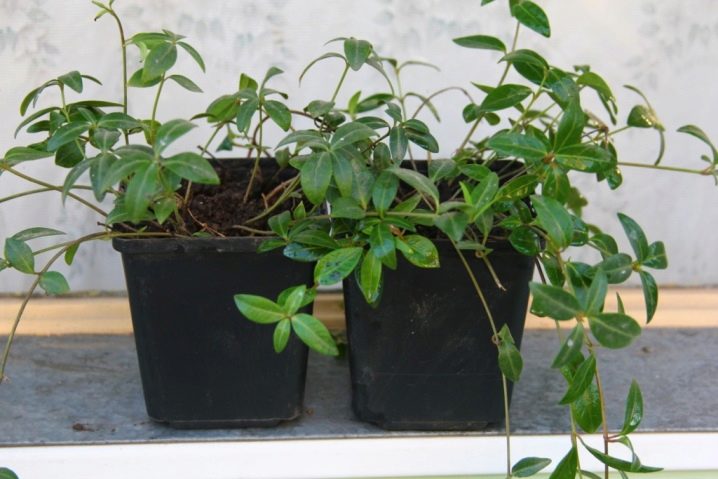
Cuttings are also a fairly popular breeding method for periwinkle. In this case, young shoots of the plant are separated or cut off from the main bush and buried in a separate place with the same soil and moisture level. When planting, only the sheet part should be left on the surface, the entire base should be in the ground.

Breeding propagation is much less popular, since this procedure requires free space around the plant.... The twig should be bent to the ground and covered with earth. In this case, you should wait for at least partial rooting of the shoot, then separate it from the bush part and plant it in a designated and prepared place (the method resembles the way of propagation of ordinary strawberries).

The seeds of the plant should be monitored much more carefully. The planting process itself should be carried out in the spring; shallow wooden or polymer boxes are best suited for this. Place the seeds in the soil to a depth of no more than 2-3 cm, then cover with an impermeable film or cloth (a strictly defined microclimate should be created). This option is suitable for growing periwinkle only at home (up to 22-23 degrees Celsius). Be sure to water the plant occasionally and ventilate the first shoots to keep them viable.
After the first seedlings germinate, remove the film and expose the pot to the sun.
A pick should be carried out only after the sprouts have 4 full leaves, while the height of the plant should be at least 8 centimeters.
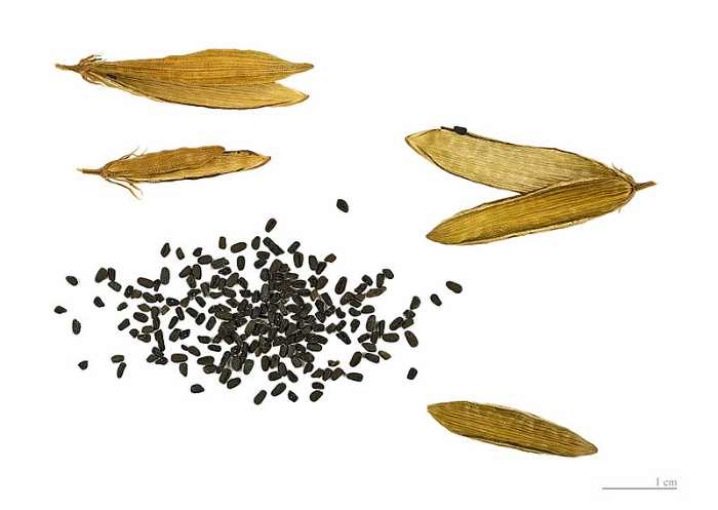
How to care?
For any owner, periwinkle will not cause great difficulties in care, because it is one of the most unpretentious perennial plants. Everything that will be indicated below is just recommendations with which you can grow beautiful, and, most importantly, healthy flowers.
- Location. Periwinkle is not bad for open sunlight and can feel great in cool shade, but it takes root best in a semi-dark, chilled place. Try to find a place where the plant would be fully illuminated in the morning or in the evening. The best option would be to plant a perennial under young trees - this way they will receive the necessary protection from the bright rays of the sun and will always have moisture nearby, in the upper layers of the soil.
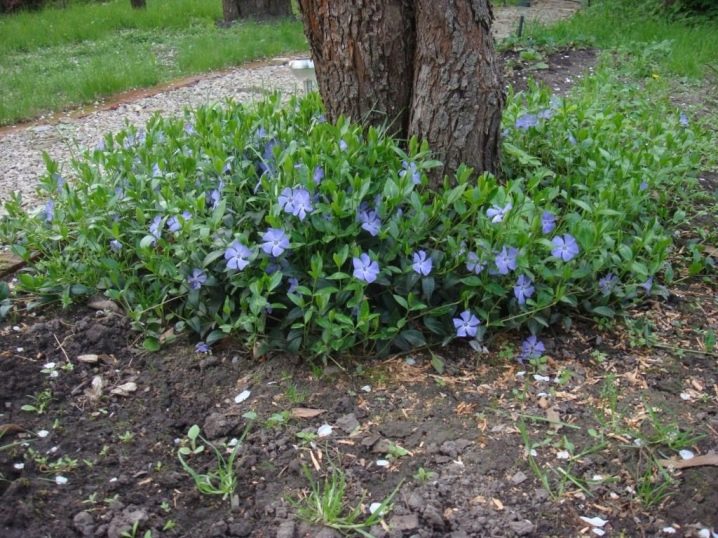
- The soil. Almost any soil is suitable for periwinkle, but it will feel best on moderately moist loams with some humus content. To facilitate the initial germination of the plant in a new place (when planting sprouts), it is better to buy a special loose soil mixture.
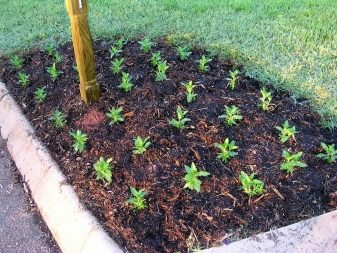

- Watering... You should not overdo it with moisture even in the initial stages after disembarkation. The plant should be watered about 2-3 times a week until complete rooting, after which watering should be reduced to 1 time per week. An exception can be made only in case of prolonged drought or wilting of several leaves or flowers.
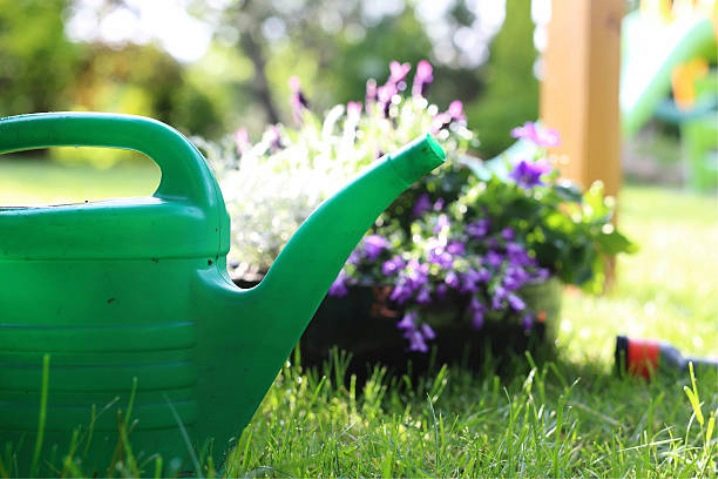
- Feeding a flower should be carried out no more than once a month. (for a young plant), over time the interval can be increased - with the appearance of a strong root system, the flower will learn to survive on its own even in poorly suitable soil. You can prepare fertilizer yourself (infusion of humus), or buy a specially prepared organic or mineral product for horticultural crops.

- If you decide to transplant the grass to a new place, then it should be carried out in the spring. Then the soil is moist and warm enough for the full development of the root system. If you are going to plant it already in the summer, then choose not a dry and preferably cloudy day.

- Periwinkle can do without leaving, but if you want your flowers to look well-groomed and beautiful, you should monitor their condition. Inspect the plant for dead branches every spring and fall. Pruning should also be done in spring, which makes the base of the plant more voluminous and fresher.
Moreover, if the conditions for periwinkle turn out to be very favorable, it can cause a lot of inconvenience - this plant is very fast growing and can fill all the beds in just a month. Therefore, do not neglect rare thinning. Do not be afraid that without proper care of the buds, the periwinkle will become less beautiful or wild - perhaps this will even give it some original charm.
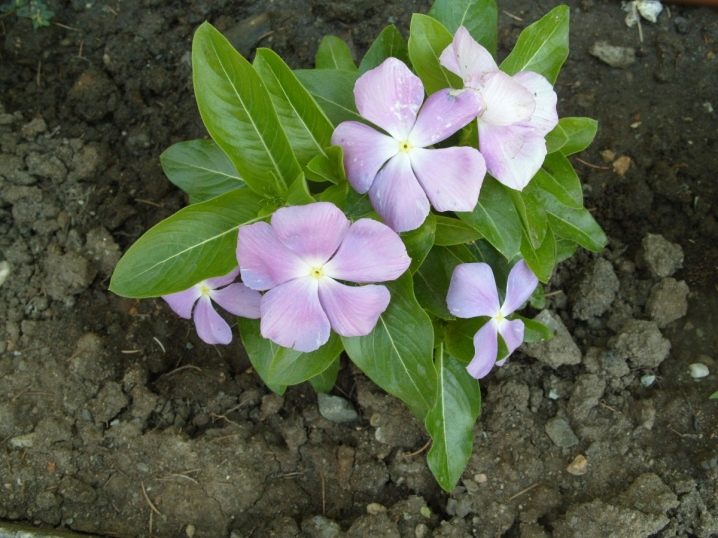
As for wintering, the large periwinkle needs to be covered with spruce branches (especially if the winter is cold, but snowless), if we talk about the small periwinkle, it perfectly tolerates any winters without any protective equipment.
Diseases and pests
Despite the unpretentiousness of the periwinkle to the external environment, try to avoid waterlogging of the soil - even with such juicy leaves and always fresh and bright flowers, it does not need a lot of moisture.
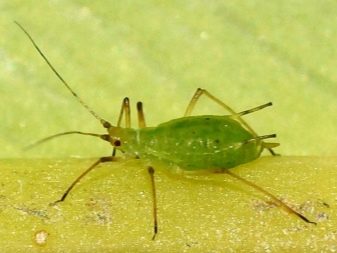

How to care for a flower, see below.
































































































The comment was sent successfully.